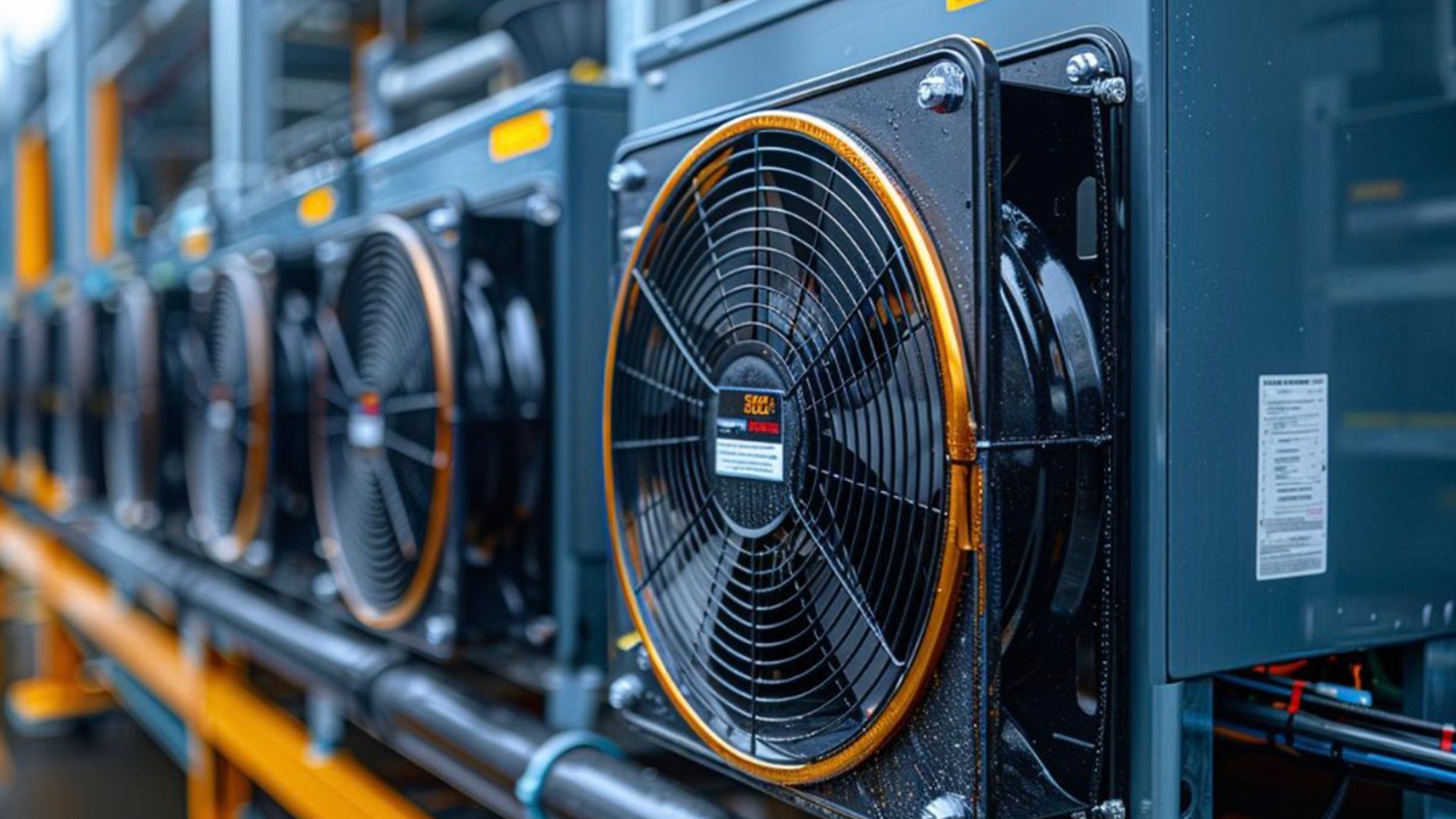The Challenge of Cooling Cryptocurrency Mining Rigs
Cryptocurrency mining rigs, especially those equipped with high-performance GPUs and ASICs, generate substantial heat as they solve complex cryptographic algorithms. Excessive heat leads to several challenges:
1. Overheating: When mining rigs overheat, they are forced to slow down or shut off to prevent damage, reducing mining productivity.
2. Thermal Throttling: Mining machines automatically reduce their performance to protect themselves from overheating, which in turn lowers hash rates and decreases mining efficiency.
3. Energy Consumption: Cooling systems in mining farms are often responsible for a significant portion of the energy consumed, especially when relying on inefficient or outdated methods.
To address these issues, miners have historically used traditional cooling equipment, but as the industry grows, the need for smarter, more efficient solutions is becoming increasingly evident.
Traditional Cooling Methods: The Role of Dryer Hoses
Dryer hoses, typically used for household appliances, have found their way into cryptocurrency mining farms due to their flexibility and ease of use. While simple, these hoses offer several benefits in controlling airflow and directing hot air away from mining rigs.
1. Heat Extraction
Dryer hoses are designed to extract hot air from enclosed spaces. In mining setups, they serve the same function by removing heat generated by mining rigs and directing it outside the room or facility. This helps prevent heat buildup around the rigs, allowing them to continue operating without interruption.
2. Cost-Effectiveness
For small to medium-sized mining operations, dryer hoses provide a low-cost cooling solution compared to industrial-scale cooling systems. They are affordable, easy to install, and readily available, making them a practical choice for miners who need quick and inexpensive airflow management.
3. Flexibility and Adaptability
One of the key advantages of dryer hoses is their flexibility. They can be installed in tight spaces, easily routed around mining rigs, and adjusted as necessary. This adaptability allows miners to scale their cooling setups as their operations grow.
Limitations of Traditional Cooling Solutions
Despite their benefits, traditional cooling solutions like dryer hoses have limitations that hinder their effectiveness in larger mining operations. Some of these challenges include:
1. Limited Cooling Capacity: Dryer hoses are not designed for large-scale industrial use. As mining farms grow, the sheer volume of heat generated by hundreds or thousands of rigs can overwhelm these basic systems, leading to insufficient cooling.
2. Manual Management: Traditional cooling systems require manual monitoring and adjustments to maintain optimal airflow. This can be labor-intensive, especially for large mining operations, and leaves room for human error.
3. Energy Inefficiency: While dryer hoses are cost-effective upfront, they are not the most energy-efficient solution in the long run. In large operations, reliance on basic equipment can lead to higher energy consumption as fans and cooling systems work harder to keep up with the heat output.
The Rise of Intelligent Ventilation Solutions
As the cryptocurrency mining industry continues to expand, miners are turning to more advanced cooling technologies to manage heat more effectively and efficiently. Intelligent ventilation systems, equipped with sensors, automation, and smart controls, are emerging as the future of cooling in mining operations.
1. Automated Airflow Management
One of the standout features of intelligent ventilation systems is their ability to automatically adjust airflow based on real-time data. Sensors monitor the temperature and humidity levels in the mining environment, and the system adjusts fan speeds and ventilation routes accordingly. This dynamic management ensures that mining rigs receive the optimal amount of cooling at all times, preventing overheating without wasting energy.
2. Energy Efficiency
Intelligent ventilation systems are designed to be energy-efficient. By precisely controlling airflow, these systems reduce the amount of energy needed to maintain a stable temperature. Instead of running fans at full capacity all the time, the system only activates them when necessary, saving energy and reducing operational costs.
Additionally, many intelligent cooling systems are compatible with renewable energy sources, making them an attractive option for mining operations seeking to reduce their carbon footprint.
3. Scalability
As cryptocurrency mining farms grow, so do their cooling needs. Intelligent ventilation systems are highly scalable, allowing miners to easily expand their cooling infrastructure as their operations grow. Unlike traditional equipment, which may require frequent manual adjustments and replacements, smart systems can adapt to changing conditions and accommodate increased workloads without sacrificing efficiency.
4. Remote Monitoring and Control
Another key advantage of intelligent ventilation systems is the ability to monitor and control cooling operations remotely. Using advanced software, miners can access real-time data on temperature, humidity, and airflow from anywhere in the world. This remote access allows for proactive management of cooling issues before they escalate, ensuring that mining rigs remain operational and efficient.
Integration of Traditional and Intelligent Ventilation Systems
While intelligent ventilation systems offer a wide range of benefits, integrating them with traditional cooling solutions like dryer hoses can provide an effective hybrid approach. Here’s how:
1. Supplementing Basic Cooling with Intelligence
Dryer hoses can continue to play a role in directing airflow and removing hot air, particularly in smaller mining operations or as a backup to the primary cooling system. By integrating intelligent ventilation controls, miners can automate and optimize the use of these hoses, ensuring they are only used when needed and reducing manual intervention.
For example, an intelligent system can detect when a specific mining rig is overheating and activate dryer hoses in that area, directing airflow exactly where it’s needed without over-cooling other rigs.
2. Cost-Effective Transition to Smart Solutions
For miners looking to upgrade their cooling systems without a significant upfront investment, combining traditional equipment with intelligent systems offers a gradual, cost-effective transition. Instead of replacing all equipment at once, miners can integrate smart controls with their existing infrastructure, gradually phasing in more advanced solutions over time.
3. Improved Efficiency with Minimal Downtime
By combining traditional and intelligent cooling methods, mining farms can improve efficiency without the need for extensive downtime. The hybrid system ensures that mining rigs remain operational while the intelligent system optimizes airflow and prevents overheating. This combination also provides redundancy, ensuring that even if one part of the system fails, the mining operation continues to function.
The Future of Cooling for Cryptocurrency Mining
As the cryptocurrency industry continues to evolve, the demand for efficient, scalable, and sustainable cooling solutions will only grow. The integration of traditional cooling equipment like dryer hoses with intelligent ventilation systems represents a key trend in the future of mining operations.
Some potential future developments include:
1. AI-Driven Cooling Systems: Future intelligent ventilation systems may incorporate AI algorithms to predict and respond to cooling needs based on historical data. This would allow for even more precise temperature control and further reduce energy consumption.
2. Liquid Cooling Integration: In addition to ventilation systems, liquid cooling solutions may be integrated with intelligent controls to provide a comprehensive cooling strategy for mining farms. This combination could offer superior cooling efficiency, especially for high-density mining setups.
3. Sustainability Focus: As environmental concerns grow, mining operations will continue to seek out cooling solutions that minimize energy consumption and reduce their carbon footprint. Intelligent ventilation systems powered by renewable energy sources will likely play a significant role in this shift toward greener mining practices.
Conclusion
The future of cooling for cryptocurrency mining machines lies in the integration of traditional equipment like dryer hoses with intelligent ventilation systems. This hybrid approach provides a cost-effective, scalable, and energy-efficient solution for managing heat in mining operations. As the industry continues to evolve, investing in smarter cooling technologies will be essential for maximizing mining efficiency, reducing operational costs, and ensuring the longevity of mining equipment.


